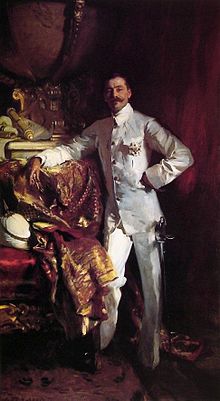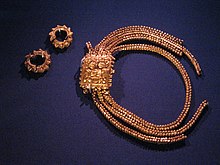
Singapore, officially the Republic of Singapore, is a sovereign island city-state in maritime Southeast Asia. It lies about one degree of latitude north of the equator, off the southern tip of the Malay Peninsula, bordering the Straits of Malacca to the west, the Riau Islands (Indonesia) to the south, and the South China Sea to the east. The country's territory is composed of one main island, 63 satellite islands and islets, and one outlying islet, the combined area of which has increased by 25% since the country's independence as a result of extensive land reclamation projects. It has the second greatest population density in the world. The country has almost 5.7 million residents, 61% (3.4 million) of whom are Singaporean citizens. There are four official languages of Singapore: English, Malay, Chinese and Tamil, with English being the lingua franca. Multiracialism is enshrined in the constitution, and continues to shape national policies in education, housing, and politics.

The Straits Settlements were a group of British territories located in Southeast Asia. Originally established in 1826 as part of the territories controlled by the British East India Company, the Straits Settlements came under British Raj control in 1858 and then under direct British control as a Crown colony on 1 April 1867. In 1946, following the end of the Second World War and the Japanese occupation, the colony was dissolved as part of the Britain's reorganisation of its dependencies in the area.
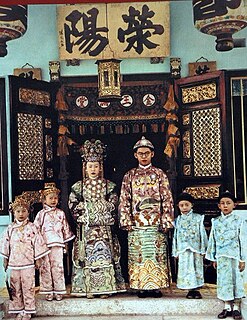
The Peranakans are an ethnic group defined by their genealogical descent from the first waves of Hoklo settlers in the Malay Peninsula and Indonesian Archipelago. Peranakan culture, especially in the dominant Peranakan centres of Malacca, Singapore, Penang and Medan is characterized by its unique hybridization of ancient Chinese culture with the local cultures of the Nusantara region, the result of a centuries-long history of transculturation and interracial marriage.
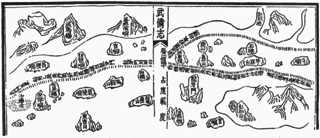
Temasek is an early recorded name of a settlement on the site of modern Singapore. The name appears in early Malay and Javanese literature, and it is also recorded in Yuan and Ming Chinese documents as Danmaxi. Two distinct settlements were recorded in Temasek – Long Ya Men and Ban Zu. The name is used in modern-day Singapore for national honours as well as institutions and corporations.

Bintan Island or Negeri Segantang Lada is an island in the Riau archipelago of Indonesia. It is part of the Riau Islands province, the capital of which, Tanjung Pinang, lies in the island's south and is the island's main community.
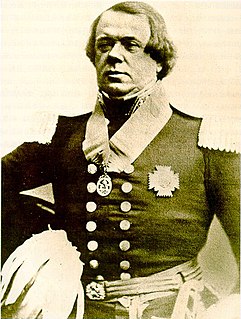
Sir Samuel George Bonham, 1st Baronet was a British colonial governor, who became the 4th Governor of the Straits Settlements and the 3rd Governor of Hong Kong.
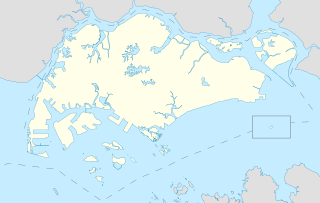
Seletar is an area located in the north-east of Singapore. Its name can also refer to the Seletar Planning Area, situated in the North-East Region of Singapore. The place name was derived from the Malay subgroup who were indigenous to the area, the Orang Seletar. It shares boundaries with the planning areas of Sengkang to the south, Punggol to the east, Yishun and Simpang to the west, as well as the Straits of Johor to the north.

The Singapore Stone is a fragment of a large sandstone slab which originally stood at the mouth of the Singapore River. The large slab, which is believed to date back to at least the 13th century and possibly as early as the 10th or 11th century, bore an undeciphered inscription. Recent theories suggest that the inscription is either in Old Javanese or in Sanskrit, which suggested a possibility that the island was an extension of the Majapahit civilization in the past.

The founding of modern Singapore is said to have started with the establishment of a British trading post in Singapore in 1818 to 1819 by Sir Stamford Raffles and its founding as a British colony in 1824 has generally been understood to mark the founding of colonial Singapore, a break from its status as a port in ancient times during the Srivijaya and Majapahit eras, and later, as part of Melaka and Johor.

Fort Canning Hill, formerly Government Hill, Singapore Hill and Bukit Larangan, is a small hill about 48 metres (157 ft) high in the southeast portion of the island city-state of Singapore, within the Central Area that forms Singapore's central business district. Although small in physical size, it has a long history intertwined with that of the city-state due to its location as the highest elevation within walking distance to the city's civic district within the Downtown Core. It is also a popular venue for music shows and concerts.

The term "British Malaya" loosely describes a set of states on the Malay Peninsula and the island of Singapore that were brought under British hegemony or control between the 18th and the 20th centuries. Unlike the term "British India", which excludes the Indian princely states, British Malaya is often used to refer to the Federated and Unfederated Malay States, which were British protectorates with their own local rulers, as well as the Straits Settlements, which were under the sovereignty and direct rule of the British Crown, after a period of control by the East India Company.
Archaeology in Singapore is a niche but growing discipline. Although there is generally a lack of government support for archeological work, many artifacts have been unearthed at sites around the island, helping to give a clearer picture of Singapore's history, both concerning the early history of Singapore and its subsequent colonial settlement following the founding of modern Singapore, the former being particularly useful in revealing archaeological evidence reflecting references to settlements such as Temasek, Ban Zu, Long Ya Men and the Kingdom of Singapura in chronicles and records.

The early history of Singapore refers to its pre-colonial era before 1819, when the British East India Company was led by Sir Stamford Raffles established a trading settlement on the island and set in motion the history of Singapore.

The National Museum of Singapore is a museum in Singapore dedicated to the history of Singapore. It is the oldest museum in Singapore, with its history dating back to 1849, when it was started as a section of a library at Singapore Institution and called the Raffles Library and Museum. After several relocations, in 1887 it moved to its permanent site at Stamford Road in the Museum Planning Area. Between 1993 and March 2006, it was known as the Singapore History Museum; it was given its present name in 1965.
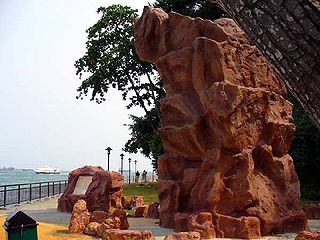
Long Ya Men or Dragon's Teeth Gate, is the name Chinese explorer Wang Dayuan recorded for Batu Belayar, a craggy granite outcrop that formerly stood at the gateway to Keppel Harbour in Singapore. In his description, “The strait runs between the two hills of the Danmaxi (Temasek) natives which looked like dragon’s teeth.” From there, the name Long Ya Men or Dragon Teeth’s Gate was born.

Fort Pasir Panjang or Labrador Battery is located within the lush Labrador Park at the southern tip of Singapore island. It was one of the 11 coastal artillery forts built by the British in the 19th century to defend the western passageway into Keppel Harbour against piracy and foreign naval powers. During the 1942 Battle of Pasir Panjang, the fort played a supporting role but a limited one in defending the Malay Regiments against the Japanese invasion at Bukit Chandu. In 1995, the site was gazetted by the National Heritage Board as one of the 11 World War II sites in Singapore.

The following outline is provided as an overview and topical guide to Singapore:
The names of Singapore include the various historical appellations as well as contemporary names and nicknames in different languages used to describe the island, city or country of Singapore. A number of different names have been given to the settlement or the island of Singapore all through history, the earliest record may have been from the 2nd century AD. Possible mentions of Pulau Ujong, the name for the island of Singapore, may be found in Chinese works, and it was also referred to as Temasek in Malay and Javanese literature. Sometime in the 14th century the name was changed to Singapura, which is now rendered as Singapore in English. Singapura means "Lion City" in Sanskrit, and Sang Nila Utama is usually credited with naming the city, although its actual origin is uncertain.

The Kingdom of Singapura was a historical Malay kingdom thought to have been established upon the main island of Singapore, from 1299 to 1398. Conventional view marks c. 1299 as the founding year of the kingdom by Sang Nila Utama, whose father is Sang Sapurba, who according to legend is the common great ancestor of most of the Malay monarchies in the Malay World. The historicity of this kingdom, based on the account given in the Malay Annals, is the subject of academic debates, and many historians consider only its last ruler Parameswara a historically attested figure. Archaeological evidence from Fort Canning Hill and the nearby banks of the Singapore River has nevertheless demonstrated the existence of a thriving settlement and a trade port in the 14th century.

Ban Zu or Banzu was a port settlement believed to have thrived in Singapore during the 14th century. It is thought to be located on Fort Canning Hill and the area on the north bank of the Singapore River basin between the hill and the sea. It was mentioned by the Chinese traveller Wang Dayuan in his work Daoyi Zhilüe together with Long Ya Men as the two settlements that made up Temasek. It may have been abandoned before 1400 after an attack by either the Siamese or the Majapahit.

